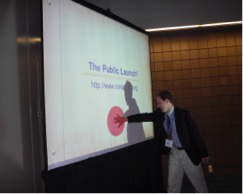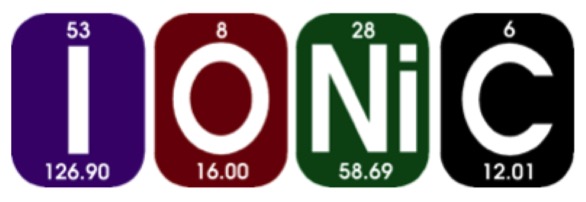Joanne L. Stewart, Professor of Chemistry, Hope College, March 12, 2018
Contact at: stewart@hope.edu
This is not a guide for designing a community of practice—those exist (Cambridge, Kaplan, & Suter, 2005; Wenger, McDermott, & Snyder, 2002). It is, instead, a story of one community of practice, IONiC. It is being told because it may be useful to the work of the Great Lakes Colleges Association (GLCA) and Global Liberal Arts Alliance’s (GLAA) Consortium for Teaching and Learning. The similarities are many. The community in this story exists across multiple institutions of higher education. It was started by a small number of faculty members at schools that focus on undergraduate education. It does its work both virtually and face-to-face. However, there is one big difference. This community is focused on one discipline. In fact, it’s focused on one subdiscipline in one discipline. I would argue, however, that it is the passion for learning in community that has been more important to its success than the narrow disciplinary focus. And I would argue that participants in the GLCA/GLAA Consortium for Teaching and Learning share an equally great passion for improving student learning at their institutions. So I offer this story.
The early history: Starting IONiC
In true liberal arts fashion, the chemists who started IONiC were initially inspired by a group of classicists. (Note: The leaders of IONiC love bad acronyms spelled with symbols from the Periodic Table. Hence, IONiC stands for Interactive Online Network of Inorganic Chemists. It is spelled with the symbols for iodine, oxygen, nickel, and carbon.) In a Mellon Foundation-supported meeting of the early IONiC organizers in 2006, Kenny Morrell, Professor of Classics at Rhodes College, described the Sunoikisis project. Sunoikisis is a consortium of classics programs whose members collaboratively develop new classics courses and return to their respective institutions to teach them. They were early adopters of technology to facilitate collaboration. But, instead of sharing whole courses, we wanted to develop and share smaller bits of curricula, so we set to work designing a digital library for sharing teaching resources. However, our wise technology consultant, Ethan Benatan, explained that we would have a larger impact by focusing on community instead of content. It has taken ten years and much trial and error to learn how right Ethan was.
While we ruminated on what a community might look like, we set to work on website design. The curricular bits were named learning objects, which Wikipedia defined as “a collection of content items, practice items, and assessment items that are combined based on a single learning objective.” The learning objects were organized two ways, by content area and pedagogical approach. Content areas included categories like coordination chemistry, solid state and materials, and bioinorganic chemistry. Pedagogical approaches included in-class exercises (IONiC has promoted active learning from the beginning), problem set questions, lab experiments, and what eventually became the group’s killer app—literature discussions. A literature discussion is a carefully scaffolded set of reading or discussion questions that guide students to learn fundamental chemistry concepts through reading current research papers.

Setting up the website
The website was storyboarded with colorful icons for each of the content areas. Discussion forums were added to support community conversations. With a small grant from NITLE (National Institute for Technology in Liberal Education), a website developer was hired to set up the site. It was built on a Drupal platform. Drupal is an open-source content management system that provides flexibility for growth and adding functionality. We began to populate the site with content.
The site was formally launched at the Spring 2008 American Chemical Society national meeting in New Orleans.

Adam Johnson (Oberlin ’93), Professor of Chemistry at Harvey Mudd College, pushing the official launch button for the VIPEr website at the Spring 2008 American Chemical Society meeting.
Staying true to our love of Periodic Table acronyms, the site was called VIPEr: The Virtual Inorganic Pedagogical Electronic Resource (aka Vanadium, Iodine, Phosphorus, Erbium). We even went so far as to hire a logo designer, with the plea from one IONiC leader that the snake not look too scary.
Managing the site
The Leadership Council (LC) carries out “site admin” duties collaboratively. Each day of the week is assigned to one LC member. Early on, the duties included approving new learning objects, managing user roles and permissions cleaning up spam, and posting something, anything, on the site to keep it growing. Over time, the management duties have become more complicated and there are new management positions such as learning object editor and blog manager. Recently, new site administrators have been added as a mechanism for developing new VIPEr leaders and turning over the membership of the Leadership Council.
Communication
Initially, the LC’s primary means of communication was email. However, Ethan, the technology expert, quickly became frustrated by the barrage of lengthy group-related email threads and introduced us to the idea of a persistent Skype chat (York, 2010) for group business. What started as an attempt to avoid email overload has since evolved a life of its own and is now an integral part of our lives. The chat room has brought us closer together, serving purposes ranging from advice on effective pedagogy to effective parenting and facilitating that ever-elusive work-life “transcendence” (we don’t believe in work-life balance). Skype has become a means for professional collaboration, a “just-in-time” teaching and mentoring tool, and a stress relief valve and avenue for support.
The Leadership Council meets regularly via video conference. While the conferencing software has changed several times (the current choice is Zoom), the meeting design has not. Facilitating and minute-taking duties are rotated. There is a Google Doc for each meeting with the agenda. The minutes are recorded directly into that document in real time, with everyone chipping in as needed. “Old homework,” or tasks that individuals need to complete, is reviewed at the beginning of the meeting, and “new homework” is recorded during the meeting. At the end of the meeting, a fresh copy of the agenda/minutes is created, dates are updated for the next meeting, completed homework is deleted, and new homework is moved to the top of the doc. Between meetings, participants post status updates on their homework and add agenda items.

The evolution of the VIPEr logo as evidence of community growth and change.
Growing the community
Community growth has depended primarily on two outreach efforts—an annual research symposium at the spring national American Chemical Society (ACS) meeting and faculty development workshops. The annual ACS symposium is called “Undergraduate Research at the Frontiers of Inorganic Chemistry.” The symposium has proven popular (approximately 30 talks and 80 posters each year) because it provides a welcoming environment for faculty and students from both large and small institutions to share the research accomplishments of undergraduate students. We also host an informal social function at the ACS meeting each year that provides valuable face time. This is critical for developing the relationships necessary for a thriving, and primarily virtual, community.
The faculty development workshops come in several different flavors. We have given short, half-day workshops at regional chemistry meetings. We have hosted longer workshops for the GLCA and Mellon 23, supported by grants from those organizations. But our primary outreach effort has been an annual “back to grad school” workshop supported by a grant from the National Science Foundation. These workshops are five days long and have been held at various research institutions around the country. Workshop participants collaboratively develop curricula and publish their developments to the VIPEr site.
As of March 2018 our outreach efforts have “encoiled” over 1,200 registered faculty participants from around the world, and they have developed over 860 learning objects posted to the site.
What’s next?
In what may appear to be a logical and linear trajectory but has really been more Brownian motion-like, the IONiC community has progressed from developing the website to growing the community to empowering the community to contribute and adapt shared teaching resources. But does it make a difference? Our next step is to go into the classroom and measure the impact of the project on student learning and faculty change. This is an ambitious “grand experiment,” funded by the National Science Foundation that will involve sixty chemistry faculty from different institutional types. In cohorts of twenty, the faculty will collaboratively develop a foundation inorganic course (American Chemical Society, 2015) that covers a shared set of core topics while allowing significant instructor flexibility. The course will incorporate several VIPEr learning objects and several shared student learning assessments. To study faculty change, some participants will be observed before and after the development of this course. It was beyond our imagination ten years ago to think that we might eventually have an opportunity to impact the teaching of inorganic chemistry across the country.
Conclusion
What lessons have been learned that might be useful for the GLCA/GLAA Consortium for Teaching and Learning? The most important lesson was described in a Carnegie blog called Organizing for Transformational Change (McKay, 2016). The author wrote “the way forward requires engaging key stakeholders not just in mapping the problem but also in action to solve the problem.” In other words, websites and learning objects may be important products, but it’s the engagement of people in learning and creating together that is the key to change.
A second lesson is that getting started is not particularly difficult, time consuming, or expensive. A small group of passionate leaders who meet regularly and keep track of what they’re doing is all that is needed. The difficulty, the time, and the money are not zero, but they are not as large as one might think. Setting up a shared Google calendar, a virtual meeting room, and a Google Doc for agendas and minutes is how it starts.
Finally, one aspect that hasn’t been mentioned that is absolutely essential—FUN! I suspect that each successful community of practice develops its own sense of humor, inside jokes, and embarrassing moments. But this means intentionally designing in time for fun in addition to time for work. This is captured in IONiC’s byline: We’re more serious about chemical education than you might think!
References
American Chemical Society (2015). ACS Guidelines and Evaluation Procedures for Bachelor’s Degree Programs.
Cambridge, D., Kaplan, S., & Suter, V. (2005). Community of Practice Design Guide: A Step-by-Step Guide for Designing & Cultivating Communities of Practice in Higher Education.
McKay, S. (2016, June 8). Organizing for Transformational Change.
Wenger, E., McDermott, R., & Snyder, W. (2002). Cultivating Communities of Practice: A Guide to Managing Knowledge: Harvard Business Review Press.
York, D. (2010, Dec 3) Skype and the Incredible Power of Persistent Group Chats.


